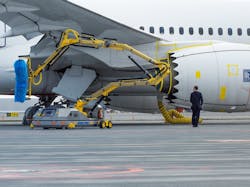The aerodynamic effects on dirty aircraft in the quest for greater sustainability
VALLENTUNA, Sweden - It’s a question that may be as old as powered flight itself, but the conversation continues to this day – what is the aerodynamic effect of dirt on an aircraft, and how does a clean aircraft generate greater fuel savings? AviationPros reports. Continue reading original article.
The Military & Aerospace Electronics take:
14 Feb. 2022 - Jan Brunstedt, the CEO of Aviator Robotics AB, the designers and manufacturers of Nordic Dino – an advanced semi-automated aircraft exterior cleaning technology – and a family member of Avia Solutions Group, says “the results are already there to be seen for themselves when it comes to fuel savings generated with the assistance of clean aircraft.
“While the science behind the measurement of savings may be somewhat vague, there can be no doubt that a newly cleaned aircraft can generate what is commonly regarded in the industry as a saving of approximately 0.5 percent.”
To illustrate the point, the CEO cites tests conducted in the 1990s on a McDonnell Douglas MD-80 aircraft. In the controlled tests, a 90-minute flight was conducted on an aircraft that had only been given a primer coating to its exterior. Its fuel consumption was then measured. The aircraft was then painted and a flight matching the parameters of the first was once again conducted and the fuel consumption was again measured. The result showed that the newly painted aircraft consumed 1.5 percent less fuel than the primed aircraft.
Related: Efficiency, connectivity, thermal management drive aircraft development
Related: Airbus focuses on efficiency, environment throughout A350 XWB life cycle
Related: It’s all about thermal efficiency
Jamie Whitney, Associate Editor
Intelligent Aerospace
